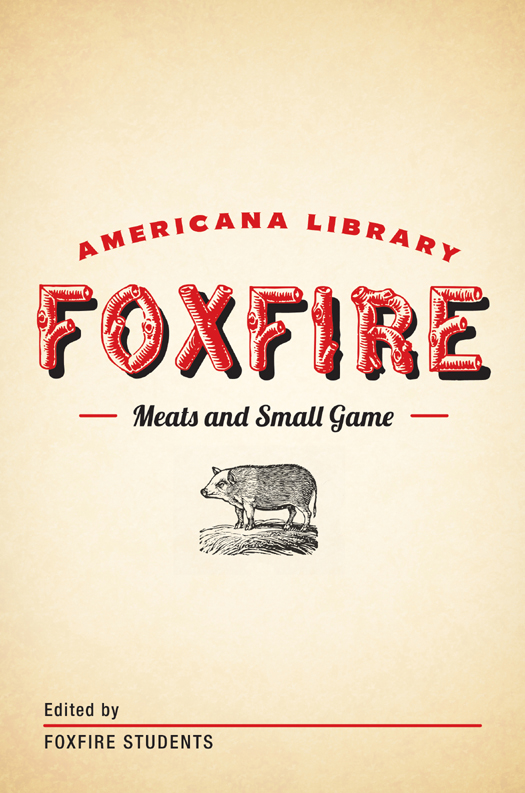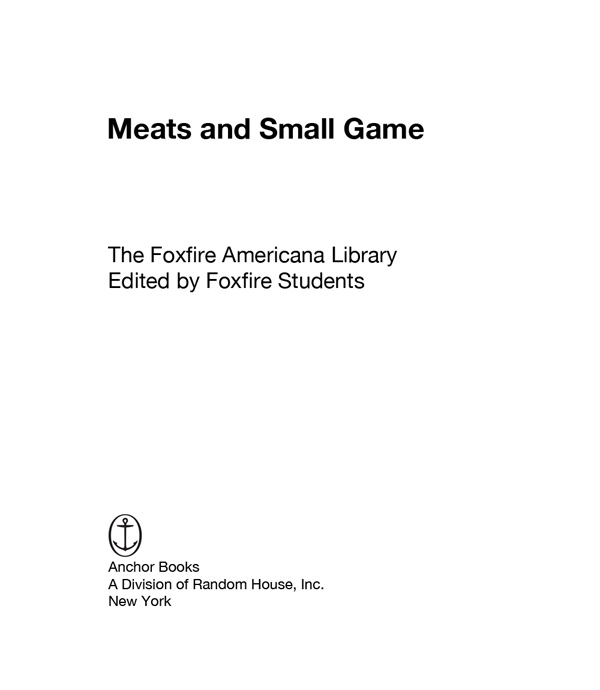ANCHOR BOOKS EDITION, SEPTEMBER 2011
Copyright 1972, 1999, 2004 by The Foxfire Fund, Inc.
All rights reserved. Published in the United States by Anchor Books, a division of Random House, Inc., New York.
Slaughtering Hogs and Dressing and Cooking Wild Animal Foods originally appeared in The Foxfire Book, 1972 by Brooks Eliot Wigginton. Reprinted by permission of Random House, Inc.
Fishing originally appeared in Foxfire 11, 1999 by The Foxfire Fund, Inc. Reprinted by permission of Random House, Inc.
Turtles from Creek to Crock originally appeared in Foxfire 12, 2004 by The Foxfire Fund, Inc. Reprinted by permission of Random House, Inc.
Anchor Books and colophon are registered trademarks of Random House, Inc.
eISBN: 978-0-307-94823-6
v3.1
Table of Contents
A NOTE ABOUT THE FOXFIRE AMERICANA LIBRARY SERIES
For almost half a century, high school students in the Foxfire program in Rabun County, Georgia, have collected oral histories of their elders from the southern Appalachian region in an attempt to preserve a part of the rapidly vanishing heritage and dialect. The Foxfire Fund, Inc., has brought that philosophy of simple living to millions of readers, starting with the bestselling success of The Foxfire Book in the early 1970s. Their series of fifteen books and counting has taught creative self-sufficiency and has preserved the stories, crafts, and customs of the unique Appalachian culture for future generations.
Traditionally, books in the Foxfire series have included a little something for everyone in each and every volume. For the first time ever, through the creation of The Foxfire Americana Library, this forty-five-year collection of knowledge has been organized by subject. Whether down-home recipes or simple tips for both your household and garden, each book holds a wealth of tried-and-true information, all passed down by unforgettable people with unforgettable voices.
SLAUGHTERING HOGS
T he prime source of meat for the early family in these mountains was hogs. Part of the reason for this can be seen by a quick look at the recipes. There was almost no part of the animal that could not be used. Each farmer who kept hogs on open range in the mountains had his own identifying brand cut into the ear of each of his animals. Hogs were allowed to fatten themselves on the mast of the forestacorns, chestnuts, and so on. As Mann Norton said, My father generally kept hunnerd fifty, two hunnerd hogs in th woods. Most everbody did. Hed kill tenr twelve at one time off th mast just teat. And Bill Lamb said, Ive seed little old-fashioned blue guineas. Little old things wouldnt grow much longern that [indicating about two feet]. An Ive seed them sfat til their belliesud drag along til they couldnt get over a pole in th woods much biggern my leg.
Our contacts tell us that the sweetest meat came from hogs fattened on chestnuts. One problem, however, was that instead of rendering into good white lard, the fat of these hogs would boil down into a dark oil. Acorn mast made the meat taste bitter and altered the consistency of the fat. For these reasons, hogs to be slaughtered were often rounded up and brought down out of the mountains to the farms where they were fed on corn for anywhere from a few weeks to over a month. This removed any bitterness from the meat and softened the fat properly for rendering into lard.
Hogs were slaughtered, cut up, cured, and smoked at home. In fact, in many mountain homes today, slaughtering remains a family venturethe only difference being that now there is no more open forest range, so the hogs are kept and fed at the farm until killing time. The actual slaughtering is done in late November when the weather turns cold to stay. Since there were no meat freezers in the mountains, one had to rely on the winter weather to keep the meat from spoiling while it cured.
Most families paid strict attention to the phase the moon was in, and they killed on the first cold day they could get when the moon was right. As one said, If you kill a hog on th new of th moon, slice it and put it in a pan, itll just blow you til you cant fry th grease out of it hardly. You got tkill it on th right time of th moon. You dont never want to kill it on th new moon. Another said, Wed kill hogs on th full moon, or just about th full moon. While th moon was shrinkin, th meatd shrink. Thered be a lota lard an grease if ituz on th shrinkin of th moon. If ituz on th new moon, you wouldnt make much lard, and th meatd swell up when ycooked it steada shrink. Other farmers would kill their own hogs when the moon was shrinking, but they would take hogs to market when the moon was growing so that the meat would weigh more.
Early in the morning of butchering day, the scalding water was readied. Some farms had a cast-iron bowl about four feet in diameter set in a stone furnace. The bowl was filled with water, a fire built in the furnace, and by the time the hog was killed, the water would be hot. Other families simply had an oil drum tipped half over and filled half full with water. Into this they put heated rocks which heated the water. Others heated water in pots to pour over the carcass. The water in all cases was heated nearly to the boiling point, and ashes were often added to help loosen the hair.
Meanwhile, the hog was killed (either by a sharp blow on the head with a rock or axe head, or by shooting it in the back of the head or between the eyes), and its jugular vein (on the left side of the throat about three inches back from the jawbone) pierced immediately. As one described it, Stickim right in th goozleere.
When the bleeding slowed, the hog was dragged to the scaldin place and dipped in the hot water and rolled over to loosen the hair (by pulling or scraping), hauled out and scraped with a not-too-sharp knife, immersed again immediately, and the procedure repeated until most of the hair was off the hide. The hog was not left in the water too long at any one time or the hair would set rather than loosen.
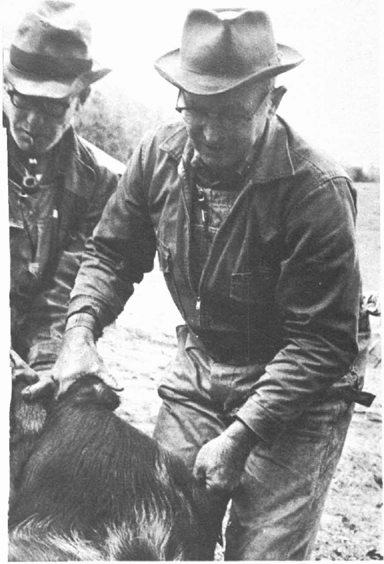
I LLUSTRATION 1 Hobe Beasley and John Hopper first lift the hogs head into a tilted barrel filled with scalding water, and leave it there long enough to loosen the hair.
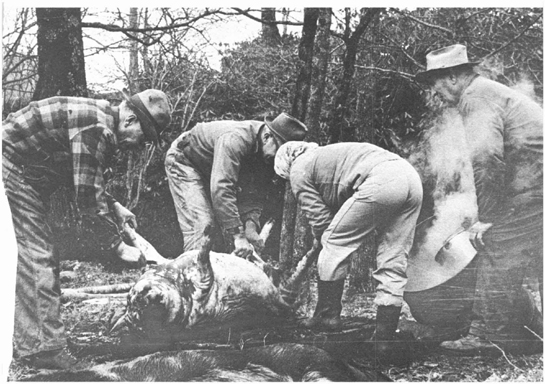
I LLUSTRATION 2 Hobe, John, Mrs. Hopper, and Lum Williams work over the hog until it is scraped clean.
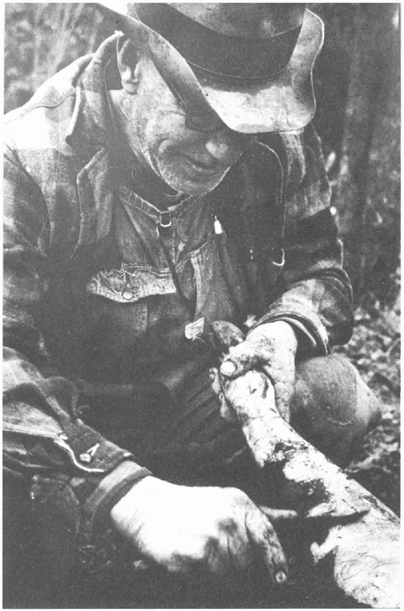
I LLUSTRATION 3 Scalding water can be poured over places where a few hairs remain and then they too are scraped off, leaving a completely bare carcass. Here Hobe finishes a leg.

I LLUSTRATION 4 The leaders in the back legs are exposed, and the gambling stick is inserted between leader and leg.
If for some reason the hog had to be killed and cleaned away from home, the men often dug a hole in the ground, filled it with water, added rocks heated in the fire, and then dipped the hog in that. Others simply laid the hog on the ground, covered him with burlap sacks, hay, grass, or anything that would help hold the heat, and then poured boiling water over him to loosen the hair. Another told us that they used to hang the hog up by the nose, cut the hide off in three-inch strips (Hitll come plumb off pertiest you ever seen), and gut it.


